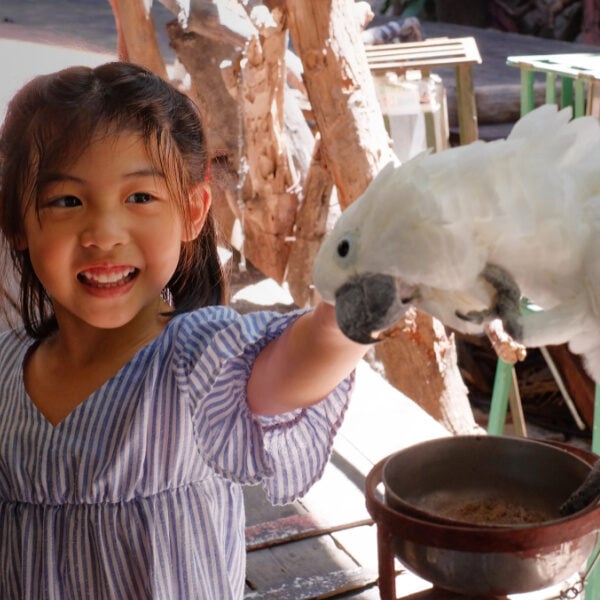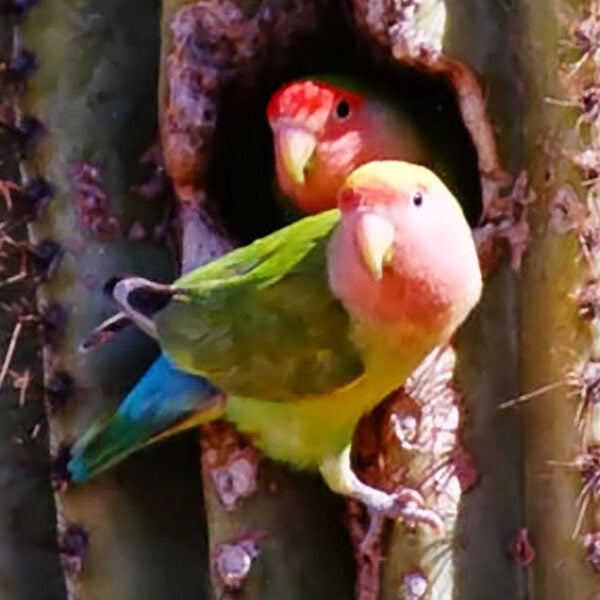Last Updated on by Mitch Rezman
What kind of parrot should I get based on this schedule?
I wake at about 5:30 AM and get ready for school. At 7:25 AM I head off for school. After at about 2:00 PM I get back home for lunch and do what I want for 2 and a half hours. I then do homework for 2 hours and then dinner and 1 hour of anything.
Our answer
You are a candidate for a budgie, The most misaligned and underrated pet bird. Budgies can be excellent talkers and great companions.
Rather than starting with the Romantic notion of a large parrot, you can get a great experience from a bird that is actually one of the better talkers in the avian world.
Budgies require the same care and discipline as a larger bird but are far more forgiving behaviorally. A relationship with a single budgie can be quite rewarding but given the fact you are a student at a young age, much can change in life.
The beauty is that should face time with your bird erodes, you can add a same-sex (you don’t want eggs) to the caged environment keeping him or her quite happy without your intervention.
Disco the parakeet can produce more than one hundred phrases illustrating the potential for rewards with a small bird such as a budgie.
After providing care for a small bird you will know after one or two years if you want to move forward with a larger bird such as a true parrot. Parrots like Senegals are about the size of a cockatiel but are actually parrots in every sense of the word.
Thus starting with a budgie it’s a win-win situation for both birds and humans. You can abandon the human bird relationship and replace it with a bird relationship or move forward by adding a larger parrot to your repertoire.
How do birds make sounds?

Schematic drawing of an avian syrinx
1: last free cartilaginous tracheal ring, 2: tympanum, 3: the first group of syringeal rings, 4: pessulus, 5: membrana tympaniformis lateralis, 6: membrana tympaniformis medialis, 7: second group of syringeal rings, 8: main bronchus, 9: bronchial cartilage
Mammals talk using their larynx, tongue, and mouth/lips to pronounce words and sounds. Birds on the other hand use something called a syrinx interestingly enough the word is Greek σύριγξ for pan pipes.
You can find the syrinx in the lower portion of a bird’s trachea making birds not reliant on vocal cords as humans are.
The sound we hear comes from the vibration of the walls of the syrinx and something called the pessulus which is a delicate bar of cartilage connecting the dorsal and ventral extremities of the first pair of bronchial cartilages in the syrinx of birds.
When air flows through this system, birds are able to make sounds using a self-operating system that a bird modulates the airflow which makes the actual sound.
When a bird is mimicking sound it is Modulating muscles By changing the shape and tension of the membranes in the bronchial openings.
Some parrots, corvids, and mynas are able to mimic human speech. Many songbirds can produce multiple sounds. Conversely, new world vultures have no syrinx and communicate using their throat to make hissing sounds.
Written by Mitch Rezman
Approved by Catherine Tobsing
Your Zygodactyl Footnote
Author Profile
Latest entries
 The Traveling BirdJune 26, 2025Can You Name 5 Parrot Species That Are Living Wild in the USA?
The Traveling BirdJune 26, 2025Can You Name 5 Parrot Species That Are Living Wild in the USA? Bird BehaviorJune 26, 2025How is it Parrots Are Problem Solvers Social Animals and Even Use Tools?
Bird BehaviorJune 26, 2025How is it Parrots Are Problem Solvers Social Animals and Even Use Tools? Bird & Parrot AnatomyJune 25, 2025How a Tiny Chemical Modification Makes Parrots Nature’s Living Paintings
Bird & Parrot AnatomyJune 25, 2025How a Tiny Chemical Modification Makes Parrots Nature’s Living Paintings PigeonsJune 20, 2025How Do Parrots Thrive in Cities Outside Their Native Habitats?
PigeonsJune 20, 2025How Do Parrots Thrive in Cities Outside Their Native Habitats?





Alison Tomlin
20 May 2017Just to clarify, when you say, “After providing care for a small bird you will know after one or two years if you want to move forward with a larger bird such as a true parrot,” what would happen to the budgie in this scenario? Shelters are full of small birds who were surrendered so owners could “trade up” (I have 5 living with me at the moment, and I think you might have one, too?). I have followed you for a long time and I am sure this is not what you are intending to say.
WindyCityParrot
22 May 2017It’s exactly what I’m saying Alison.
Speaking from experience we rescued a budgie who was very unhappy solo and refused to socialize with us. Once we introduced additional birds (We now have 4 rescued budgies) he is quite happy.
It’s not much more work to care for4 budgies than one except for the additional vacuuming 🙂
birdlover
22 May 2017Sounds like you’re describing budgies as “starter” birds to practice on before moving on to larger birds. Also, budgies ARE true parrots, as are cockatiels. And Senegals are among the more difficult parrots to take care of. I also really don’t like this statement: “You can abandon the human bird relationship and replace it with a bird bird relationship.” Any bird, especially budgies and cockatiels, should have a companion regardless of their relationship with a human. It sounds like you’re encouraging this youngster to get a bird and not worry if he or she gets too busy for it because they can always just get another bird for the first. If that is anticipated, they shouldn’t get a bird at all and wait until they’re older, more settled, and able to truly care for their bird.
WindyCityParrot
22 May 2017couldn’t agree with you more birdlover, unfortunate for the “first timers” who “want a bird that talks” or I really want an african grey – i use “starter bird to put them in perspective without being demeaning
Speaking from experience we rescued a budgie who was very unhappy solo and refused to socialize with us. Once we introduced additional birds he was quite happy.
Bird companionship is highly unpredictable
re: “If that is anticipated, they shouldn’t get a bird at all and wait until they’re older, more settled, and able to truly care for their bird” teenagers fully understand and comply with logic – right?